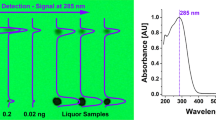Summary
The dependence of the TAR-metal chelates on the basicity of the chromatoplate, the drying temperature and time was investigated. From this it became apparent that conditions would have to be chosen carefully, if simultaneous formation of several chelate species for one metal ion was to be avoided.
Following the spraying with a 0.1% TAR solution in 95% ethanol, treatment with ammonia vapour for 30 minutes and drying in an air stream of about 40° for 30–45 minutes seemed to produce optimum analytical results for all three metals on both cellulose and silica gel. The spots remained stable for several days. Visual and instrumental detection limits ranged between 0.01–0.02μg/spot and linear calibration curves (R2 vs conc.) for up to 1μg/spot were obtained. The same wavelength (550 nm on cellulose and 560 nm on silica gel) could be used to scan for all three metals. When scanning spots in the double-beam mode, 1.5% S. D. was computed for six replicate samples. The reproducibility of this method thus becomes competitive with standard transmission techniques. It is also equal to or better than that for spot removal or elution methods.
Zusammenfassung
Die Abhängigkeit der Metallchelate des TAR [4-(2-Thiazolylazo)-resorcin] von der Basizität der Dünnschichtplatte, der Trocknungstemperatur und -zeit wurde geprüft. Daraus ergab sich, daß auf die Einhaltung dieser Versuchsbedingungen sorgfältig geachtet werden muß, wenn die gleichzeitige Bildung mehrerer Chelate eines und desselben Metalls vermieden werden soll. Nach dem Sprühen mit äthanolischer 0,1%iger TAR-Lösung erhält man für Kobalt, Kupfer und Nickel auf Zellulose oder Kieselgel die besten Analysenergebnisse, wenn man 30 Minuten mit Ammoniak räuchert und 30 bis 45 Minuten bei 40° trocknet. Die Flecken sind einige Tage beständig. Die visuelle bzw. instrumentelle Nachweisgrenze liegt zwischen 0,01 und 0,02μg/Fleck. Man erhält lineare Eichkurven (R2 gegen Konz.) bis zu 1μg/Fleck. Dieselbe Wellenlänge für Zelluloseschichten (550 nm) und Kieselgelschichten (560 nm) ist für die Messung aller drei Metalle geeignet. Bei Ausmessung der Flecken im Doppelstrahlgerät ergab sich bei sechs Parallelbestimmungen eine Standardabweichung von 1,5%. Die Reproduzierbarkeit der Ergebnisse ist also mit üblichen Verfahren durchaus vergleichbar und gleichwertig bzw. besser als bei Elution der dem Chromatogramm entnommenen Flecken.
Similar content being viewed by others
References
H. Langova-Hnilickova andL. Sommer, The Coordination and Analytical Chemistry of N-Heterocyclic Azo Dyes, Folia Facult. Scient. Natural. Univ. Purkynianae Brunensis 1968 IX, Chemia 6, 2.
H. K. Liu, K. T. Chen, andT. C. Cheng, Hua Hsueh Tung Pao1966, 365; Chem. Abstr.66, 25818.
O. Navratil andR. W. Frei, Can. J. Chem.49, 173 (1971).
O. Navratil andR. W. Frei, Analyt. Chim. Acta52, 221 (1970).
V. Miketukova andR. W. Frei, J. Chromatography47, 427 (1970).
V. Miketukova andR. W. Frei, J. Chromatography47, 435 (1970).
A. K. Babko andM. E. Vdovenko, Ukr. Khim. Zh.32, 209 (1966).
G. Boening andH. Heigener, Landwirt. Forsch.19, 117 (1966).
H. Watanabe, Nippon Kagaku Zasshi86, 513 (1965).
G. Floret andM. V. Massa, Int. Symp. IV, Chromatographic-Electrophorese. Bruxelles: Presses Académiques Européennes. 1968. p. 138.
G. Floret andM. V. Massa, Trav. soc pharm. Montpellier28, 129 (1969).
A. Galik andA. Vincourova, Analyt. Chim. Acta46, 113 (1969).
R. J. T. Graham, L. S. Bark, andD. A. Tinsley, J. Chromatography39, 218 (1969).
R. J. T. Graham, L. S. Bark, andD. A. Tinsley, J. Chromatography39, 211 (1969).
R. W. Frei andD. E. Ryan, Analyt. Chim. Acta37, 187 (1967).
R. W. Frei, R. Liiva, andD. E. Ryan, Can. J. Chem.46, 167 (1968).
R. W. Frei, J. Chromatography34, 563 (1968).
M. M. Frodyma, D. F. Zaye, andV. T. Lieu, Analyt. Chim. Acta40, 451 (1968).
R. W. Frei andH. Zeitlin, Can. J. Chem.47, 3902 (1969).
Author information
Authors and Affiliations
Rights and permissions
About this article
Cite this article
Frei, R.W., Miketukova, V. A reflectance spectroscopic study of 4-(2-thiazolylazo) resorcinol (TAR) as a spray reagent for cobalt, copper and nickel on thin-layer chromatograms. Mikrochim Acta 59, 290–302 (1971). https://doi.org/10.1007/BF01219626
Received:
Issue Date:
DOI: https://doi.org/10.1007/BF01219626



